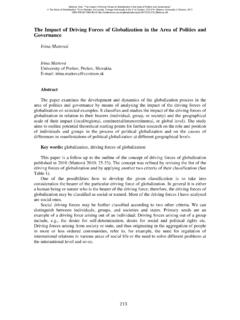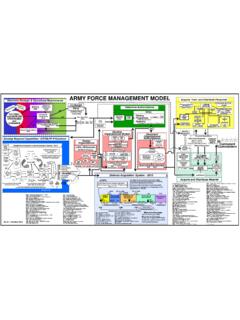Transcription of Driving Forces of Collaboration in Supply Chain: A …
1 INTERDISCIPLINARY JOURNAL OF CONTEMPORARY RESEARCH IN BUSINESS 39 COPY RIGHT 2013 Institute of Interdisciplinary Business Research NOVEMBER 2013 VOL 5, NO 7 Driving Forces of Collaboration in Supply chain : A Review Salma Ahmad Department of Business Administration, Aligarh Muslim university, Aligarh, , India Asad ullah Department of Business Administration, Aligarh Muslim university, Aligarh, , India Authors biography: Dr Salma Ahmed is an Associate Professor of Supply chain Management and Management Information System at Department of Business Administration, Aligarh Muslim University. She has over 18 years of teaching experience and has supervised many doctoral theses and dissertations.
2 She has published in a number of academic journals and has authored a book entitled How to write and Analyze Cases . Salma Ahmed is the corresponding author. Mr. Asadullah is a Research Scholar in the Department of Business Administration, Aligarh Muslim University, Aligarh, India. He has an Economics background with an in International Business. His areas of interest include Supply chain Management; Retailing and International Marketing etc. Abstract Purpose To examine different aspects of Collaboration in Supply chain over the last 19 years with the objective of developing theory for Supply chain Collaboration . Design/methodology/approach The paper is based on the review of 80 studies from 1990 to 2009.
3 Findings Major findings shows that Supply chain Collaboration can be applied into different areas like process, planning, forecasting, transportation / distribution and the prime motivating factors behind the manufacturing companies entering into Collaboration are trust, leadership, commitment, interdependence, organisational compatibility and infrastructure/technology. Research limitations/implications As the study is based on the review of literature covering many sectors, the findings of the study needs to be tested across select or specific sectors. Practical implications This study is a compilation of the work related to Collaboration in Supply chain , therefore it can be used for developing theories and identifying the Driving Forces for various industries leading to logistic Collaboration in Supply chin.
4 Originality/value The review provides a clear understanding of the current state of research in Supply chain Collaboration . Key words: Supply chain , Collaboration , Driving Forces . Paper type: Literature review. INTERDISCIPLINARY JOURNAL OF CONTEMPORARY RESEARCH IN BUSINESS 40 COPY RIGHT 2013 Institute of Interdisciplinary Business Research NOVEMBER 2013 VOL 5, NO 7 Introduction: The wide spread use of web based technologies and increase in competition has given rise to Supply chain Collaboration across many industries especially the automotive sector (Bagchi and Skjott-Larsen, 2005; Ireland, 1999). Over the years the concept of Collaboration has made a significant transition from being purely theoretical to highly adopted practice in Supply chain and as a result it has become popular among both the practitioners and academicians (Simatupang and Sridharan, 2005).
5 According to Pagell (2004) collaborative practices in Supply chain have become a well established research domain. Many companies have started getting benefited by their collaborative initiatives, as suggested by the growing literature on the subject (Narasimhan and Jayaram, 1998;Sanders, 2007, 2008; Shin et al., 2000; Simatupang and Sridharan, 2005;Vereecke and Mylle, 2006). However recent researches have acknowledged the complex role of Collaboration and its mixed results; for example, Sanders (2007) has indentified that intra-firm Collaboration had a direct impact on firm performance whereas inter- firm had an indirect impact. Similarly, Stank et al.
6 , (2001) in his empirical study for assessing the effects of internal and external Collaboration on logistics service performance have found the evidence which suggest that internal Collaboration led to the improvement of logistical service performance whereas external Collaboration did not. Another study done by Vereeck and Mylle (2006) has concluded that Collaboration improved the performances of the firms only marginally. The basic purpose of the researcher behind mentioning the above study is to provide the contextual clarity and the beginning of the review. Supply chain Collaboration (Operational Definition): According to Min et al.
7 , (2005) the concept of Collaboration has been widely examined across disciplines like Psychology (Konczak, 2001; Stern and Hicks, 2000); Marketing (Gadde et al., 2003; Jap, 1999, 2001; Perks, 2000); Management (Cross et al., 2002; Sawhney, 2002; Singh and Mitchell, 2005); Sociology (Powell et al., 2005) and Supply chain Management (Holweg et al., 2005; Tuoninen, 2004). However, in this study the concept of Collaboration has been reviewed within the Supply chain context. Collaborative practices in SCM have established itself as successful and sustainable business operations (Attaran and Attaran, 2007). Also, as per the survey conducted by SCM review and computer science corporation (SCMR and CSC, 2004) Collaboration has been cited as the INTERDISCIPLINARY JOURNAL OF CONTEMPORARY RESEARCH IN BUSINESS 41 COPY RIGHT 2013 Institute of Interdisciplinary Business Research NOVEMBER 2013 VOL 5, NO 7 most important issue.
8 It is being increasingly promoted like Silver Bullet in many areas of SCM (Kampstra et al., 2006). Hence, there is no denial of the fact that collaborative practices in the logistics area have become the source of efficiency and decision makers in the manufacturing and retailing industry have understood it. In SCM, Collaboration is a dominant concept aimed at gaining benefits and sharing results with the trading partners (Speakman et al., 1998). According to (Bowersox and Closs, 1996; Chan et al., 2003) the emphasis on the effectiveness of Supply chain in its entirety has eliminated the boundaries of the single firms and has promoted them for Collaboration between Supply chain partners, leading to the establishment of strong relationships with each other.
9 Therefore, Myhr and Speakman (2005) have described it as A Critical linking pins, as greater specialization brings in more of integration in the overall Supply chain . Taking the broader view Bahinipati et al., (2009) has defined it as A business agreement between two or more companies at the same level in the Supply chain or network in order to allow greater ease of work and cooperation towards achieving a common objective . In the words of Whipple et al., (2002) it means partners working together, in a trustful, loyal and mutual environment aimed at reducing costs and improving performance. It is seen as a powerful instrument in achieving effective and efficient Supply chain management (Fu and Piplani, 2004; Mentzer et al.)
10 , 2000). Collaboration in Supply chain has been conceptualized in various ways by researchers, as it can range from very shallow transactional focused to highly integrated close relations (Goffin et al., 2006); from collaborative communication to supplier development ( Oh and Rhee, 2008) or from inward facing to outward facing (Frohlich and Westbrook, 2001). Some definitions of Collaboration in Supply chain are presented in the table 1 below: INTERDISCIPLINARY JOURNAL OF CONTEMPORARY RESEARCH IN BUSINESS 42 COPY RIGHT 2013 Institute of Interdisciplinary Business Research NOVEMBER 2013 VOL 5, NO 7 Table. 1. Various definitions of Supply chain Collaboration : Authors Definition Bowersox et al.












